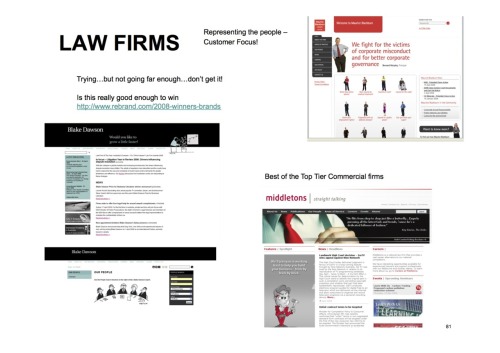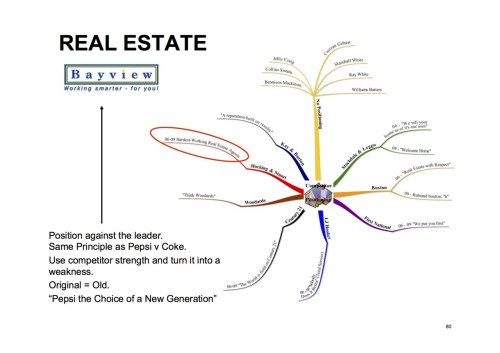
by admin | Jan 9, 2012 | Blog, Promotion, Strategy

Why is it that some of our society’s brightest minds have no idea how to translate their “no holds barred” skills from the courtroom to the public domain of marketing communication in a battle to win more clients?
Maybe they just don’t need the extra business, maybe they don’t know how, or maybe the truth is a combination of arrogance and ignorance steeped in tradition! If you want to know the historical reasons why the legal profession is the way it is when it comes to brand positioning in marketing and advertising, then you’ll see an excellent exposé here:
http://www.law.com/jsp/llf/PubArticleLLF.jsp?id=1181207138051 by the (American) National Law Journal.

by admin | Jan 8, 2012 | Blog, Strategy

Here’s an example from the Real Estate category for one of our clients.
Using the ‘Pepsi strategy against Coke’, we have used the principal of taking a leading competitor’s strength “Hardest working Real Estate Agent” by Hocking Stuart and developing a brand positioning statement that capitalizes on their weakness:
- Everyone knows that it’s not about working harder but SMARTER
- We all have the perception of Real Estate agents being ‘sharks’ who only care about their bottom line and have hence made the Bayview positioning statement all about the buyer – YOU!
The result was “Working Smarter – For You”
It is interesting to note that Hocking Stuart, the very firm that became the marketing thought leader in their field has since changed their brand positioning twice since I first wrote this and now has no slogan or positioning statement at all! Do they now think that they are all grown up and don’t need one? I wonder how this will effect them…only time will tell and unless something drastic happens only they will know! What I am confident about is that they would have been much better off by sticking to and reinforcing their original slogan “Hardest Working Real Estate Agent”. Their size in the market (number of franchises / outlets) together with their marketing budget would have ensured their prominence and top of mind awareness in the minds of their customers and prospects.
For in depth exploration of the laws and principles of Brand Positioning in the marketplace, you can’t go past Al Ries – http://www.ries.com/.
by admin | Dec 25, 2011 | Blog, Strategy
Selling the brand first
What is a brand? Sounds like a fairly basic question to ask, but you’d be surprised how many people don’t really know the answer.
A brand:
– Stands for something
– Has an emotional connection with it’s customers
– Has some need that it fulfils for it’s customer
– Is often hard to substitute
– Is unique
– Is associated with a logo and should have a tagline
How do you build a brand?
A brand is not something that naturally evolves; it is a based on a strategy to target it towards a specific group of people, and makes it relevant and appealing to them. A brand has a meaning, a benefit and an objective. The rule of thumb is to lead with an emotional benefit and support this with a rational benefit. An emotional benefit is what draws your customers to your brand and builds loyalty. For example, Nappies – the emotional benefit is that by using Brand X you will feel like you are the best mother that you can be. Whilst, the rational benefit is about performance and has to do with the practical functionality of the brand, for example, having side panels on the nappies to avoid leakage and the 100% hypoallergenic cotton fabric.
Why build a brand?
Brands are not easily substituted and this important is from a commercial perspective. If you have built a strong brand, your customers will feel loyal to your brand and this makes it difficult for competitors to take your market share. By raising the “barriers to entry” for new competitors, you are effectively making the market seem unattractive to new entrants – this keeps your customers coming back to you.
At qubePartners, a marketing agency an advertising agency, all in one, we help design, plan and execute branding strategies to ensure that your brand is as strong as it can be. Download Brand Design Questionnaire
We also recommend brand health audits on existing brands to ensure that they are relevant and building the emotional connection that is needed to create loyal customers. Download Marketing Check Fax
by admin | Dec 19, 2011 | Blog, Design, Promotion, Strategy
I am sure that you can put your hand on your heart and say that your new product or service is different and unique.
You have a point of difference that would convert a prospective customer in seconds. But how?
Here’s a checklist to ensure that you convert your prospective customers with the proper positioning strategy:
1. Look reputable:
- Have you got a logo that looks substantial?
- Do you have a tagline/slogan/positioning statement under your logo that communicates your point of difference?
- Does your website wow your customer?
- Is the content on your website relevant and proof read?
- Is all your marketing material consistent and themed?
- Do you have an office address and customer service number?
2. Build confidence:
- Do you offer guarantees and or warranties?
- Do you have testimonials from existing customers?
- Can you use the logos of existing customers to create instant credibility?
3. Get noticed:
- Do you have and regularly update a blog, to exhibit thought leadership and improve your SEO?
- Do you update your customers through email and LinkedIn/twitter/facebook?
- Do you have listings and or advertisements in business directories?
- How is your Google ranking?
- Do you do sponsored(Pay Per Click)advertising on Google?
- Do you regularly communicate through email and direct mail with your customers and new leads?
- Is your point of difference obvious and consistent in all your forms of communication?
To find out how we help our clients to play with the big boys, contact us now. We are a marketing agency and advertising agency, all in one and our website is full of information on brand identity and styling, content development and campaign development. By working on looking reputable, building confidence and getting noticed through the right positioning strategy, you’ll look just like a big player in your market, on a small budget. Remember ‘Perception is Reality’! We’ll help you to launch your brand successfully and maximise the return on your marketing investment.
by admin | Dec 16, 2011 | Blog
If you have a small budget and your marketing agency is suggesting email marketing – consider the benefits of a direct mail piece instead. The payoff between the better marketing tool can make the difference.
The main difference is that direct mail is considered a more acceptable form of communication for new leads, especially if you have a great offer. Whilst email is a cost effective was of keeping in touch with people who know and love you, but is often dismissed as spam when it arrives in the email inbox of a prospect.
If you have a decent budget, then hedge your bets and do both! But, if you don’t then you have to know the facts before you make your decision
At qubePartners, a marketing agency and advertising agency, all in one, we understand that you can’t have it all, on a small budget. So we suggest that to really get your brand noticed, consider the old fashioned way – snail/direct mail. The rationale is quite simple.
• Firstly, you are putting your brand in the hands of your target market.
• Secondly, it engages all the senses, plus addressed mail has an emotional component (i.e. it’s addressed to me, I feel special).
• And lastly, the letterbox is the least cluttered promotional channel. The inbox is full and the letterbox is quite empty!
On a small budget, it makes sense to look for a channel that is less cluttered, allows for a high degree of creativity and has a far higher chance of getting noticed. A direct mail that ends up in the bin was read first!




Recent Comments